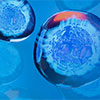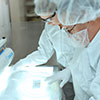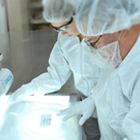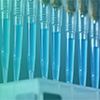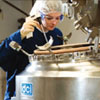Eiwitten en peptiden
Itemnummer:
(PRSI91-998)
Leverancier:
ProSci Inc.
Omschrijving:
Ubiquitin-Like-Conjugating Enzyme ATG10 (ATG10) is a ubiquitous 28kDa member of the ATG10 family protein. ATG10 acts as an E2-like enzyme, catalyzes the transfer of ATG12 to ATG5 during in the initial stages of autophagesome formation. The heterodimer of ATG5 and ATG12 subsequntly associates non-covalently with an ATG16 multimer to generate an antophagosome. ATG10 plays a role in the conjugation of ATG12 to ATG5 by interaction with MAP1LC3A. In addition, ATG10 can diretly interact with ATG5 or ATG7.
UOM:
1 * 50 µG
Itemnummer:
(PRSI4417P)
Leverancier:
ProSci Inc.
Omschrijving:
Plxdc2 peptide is used for blocking the activity of Plxdc2 antibody.
UOM:
1 * 50 µG
Itemnummer:
(PRSI4421P)
Leverancier:
ProSci Inc.
Omschrijving:
ATG12 peptide is used for blocking the activity of ATG12 antibody.
UOM:
1 * 50 µG
Itemnummer:
(PRSI92-692)
Leverancier:
ProSci Inc.
Omschrijving:
Complement factor D, also known as adipsin, is a member of the chymotrypsin family of serine proteases, which plays an essential role in host defence as the rate-limiting enzyme in the alternative pathway of complement activation. Complement factor D activates a convertase (C3bBb) responsible for cleavage of the complement protein C3, which leads to the activation of terminal complement component C5-9 to form the membrane attack complex on microbial or cellular surfaces. It also functions in the regulation of systemic energy balance and physiologic and pathologic processes, including immunity and inflammation.
UOM:
1 * 50 µG
Itemnummer:
(PRSI92-685)
Leverancier:
ProSci Inc.
Omschrijving:
Carcinoembryonic antigen-related cell adhesion molecules (CEACAMs) belong to a group of mammalian immunoglobulin related glycoproteins. They play critical roles in cell–cell recognition. CEACAM5, also called CEA and CD66e, is characterised by having seven extracellular Ig domains and a glycosylphosphatidylinositol (GPI) anchor. CEACAM5 is expressed primarily by epithelial cells, and functions as a calcium-independent adhesion molecule through homophilic and heterophilic interactions with CEACAM1. Studies have shown that CEACAM5 is overexpressed in a majority of carcinomas, and its overexpression can protect tumour cells from apoptosis. It is commonly used as a cancer marker.
UOM:
1 * 50 µG
Itemnummer:
(PRSI92-690)
Leverancier:
ProSci Inc.
Omschrijving:
Human serum albumin (HSA), the most abundant protein in human blood plasma, is essential for maintaining osmotic pressure. It is produced in the liver, consists of a single polypeptide chain, with 585 amino acids with 17 tyrosil residues and one tryptophan located in position 214. HSA is organised in three domains, I, II and III, each consisting of two subdomains, A and B. In the physiological states, HSA occurs in two forms – the non-modified HSA with a free thiol group of Cys-34, and the modified (oxidised) form (oHSA), also called human mercaptoalbumin (HMA) and human nonmercaptoalbumin (HNA), respectively. HMA and HNA are in equilibrium, depending on the redox state of Cys-34, and their ratio also varies depending on age and the diseased state. HSA functions primarily as a carrier protein for drugs, steroids, fatty acids, and thyroid hormones, and plays a role in stabilising extracellular fluid volume.
UOM:
1 * 50 µG
Itemnummer:
(PRSI92-436)
Leverancier:
ProSci Inc.
Omschrijving:
Phosphatidylinositol 5-phosphate 4-kinase type-2 alpha (PIP4K2A) is a member of the phosphatidylinositol-4-phosphate 5-kinase family. It contains 1 PIPK domain and is expressed ubiquitously, with high levels in the brain. It catalyses the phosphorylation of phosphatidylinositol 5-phosphate (PtdIns5P) on the fourth hydroxyl of the myo-inositol ring, to form phosphatidylinositol 4,5-bisphosphate (PtdIns(4,5)P2). It may exert its function by regulating the levels of PtdIns5P, which functions in the cytosol by increasing AKT activity and in the nucleus signals through ING2. It may regulate the pool of cytosolic PtdIns5P in response to the activation of tyrosine phosphorylation, negatively regulate insulin-stimulated glucose uptake by lowering the levels of PtdIns5P. It also involved in thrombopoiesis, and the terminal maturation of megakaryocytes and regulation of their size.
UOM:
1 * 50 µG
Itemnummer:
(PRSI92-574)
Leverancier:
ProSci Inc.
Omschrijving:
The EGFR subfamily of receptor tyrosine kinases is composed of EGFR, ErbB2, ErbB3 and ErbB4. The EGFR shares 43% to 44% aa sequence identity with the ECD of human EGFR subfamily. All these family members are type I transmembrane glycoproteins with an extracellular ligand binding domain. The extracellular ligand binding domain is containing two cysteine-rich domains separated by a spacer region and a cytoplasmic domain containing a membrane-proximal tyrosine kinase domain. Ligand binding could induce EGFR homodimerisation and heterodimerisation with ErbB2, resulting in cell signallling, heterodimerisation tyrosine phosphorylation and kinase activation. It can bind EGF, amphiregulin, TGF-alpha, betacellulin, epiregulin, HB-EGF, epigen, and so on. Its signalling regulates multiple biological functions including cell proliferation, differentiation, motility, and apoptosis. EGFR can also be recruited to form heterodimers with the ligand-activated ErbB3 or ErbB4. EGFR is overexpressed in different tumours. Several anti-cancer drugs use EGFR as target.
UOM:
1 * 50 µG
Itemnummer:
(PRSI92-110)
Leverancier:
ProSci Inc.
Omschrijving:
Hematopoietic Prostaglandin D Synthase (HPGDS) belongs to the GST superfamily and Sigma family. HPGDS contains one GST C-terminal domain and one GST N-terminal domain. HPGDS is highly expressed in adipose tissue, macrophages, and placenta, and it exists in the form of homodimer in living body. HPGDS is a cytosolic enzyme that isomerizes PGH(2). HPGDS is a bifunctional enzyme that catalyzes both the conversion of PGH2 to PGD2 and also shows low glutathione-peroxidase activity towards cumenehydroperoxide.
UOM:
1 * 50 µG
Itemnummer:
(PRSI96-762)
Leverancier:
ProSci Inc.
Omschrijving:
Ubiquitin carboxyl-terminal hydrolase isozyme L1 (UCHL1) ,a member of the peptidase C12 family, is also known as neuron cytoplasmic protein 9.5 (PGP 9.5) and ubiquitin thioesterase L1.About 30% of total UCHL1 is associated with membranes in brain. UCHL1 is involved both in the processing of ubiquitin precursors and of ubiquitinated proteins. This enzyme is a thiol protease that recognizes and hydrolyzes a peptide bond at the C-terminal glycine of ubiquitin. Also,UCHL1 can bind to free monoubiquitin and may prevent its degradation in lysosomes. The homodimer of UCHL1 may have ATP-independent ubiquitin ligase activity. Furthermore, the mutations of UCHL1 gene can result in parkinson disease 5.
UOM:
1 * 50 µG
Itemnummer:
(PRSI96-724)
Leverancier:
ProSci Inc.
Omschrijving:
Human recombinant TIM3 (from HEK293 cells)
UOM:
1 * 1 EA
Itemnummer:
(PRSI92-402)
Leverancier:
ProSci Inc.
Omschrijving:
Cryptic (CFC1) is a member of the epidermal growth factor (EGF)- Cripto, Frl-1, and Cryptic (CFC) family. It contains an EGF-like domain, and is glycosylated on its N-terminal during post-translational modification. Cryptic is identified as a NODAL coreceptor involved in the correct establishment of the left-right axis. It may play a role in mesoderm and/or neural patterning during gastrulation. The unnormal expression of this gene may causes a series of diseases such as HTX2, Transposition of the great arteries dextro-looped 2, and Conotruncal heart malformations.
UOM:
1 * 50 µG
Itemnummer:
(PRSI90-429)
Leverancier:
ProSci Inc.
Omschrijving:
Programmed death ligand 1 (PD-L1, B7-H1 or CD274) is a member of the growing B7 family of immune proteins that provide signals for both stimulating and inhibiting T cell activation. CD274 has been identified as one of two ligands for programmed death 1 (PD-1), a member of the CD28 family of immunoreceptors. CD274 is widely expressed in several organs such as heart, skeletal muscle, placenta and lung, and in lower amounts in thymus, spleen, kidney and liver. CD274 expression is upregulated in a small fraction of activated T and B cells and a much larger fraction of activated monocytes. CD274 expression is also induced in dendritic cells and keratinocytes after IFN-gamma stimulation. CD274 expression is also upregulated in a variety of tumour cell lines. Interaction of CD274 with PD-1 results in inhibition of TCR mediated proliferation and cytokine production, suggesting an inhibitory role in regulating immune responses. The CD274 - PD-1 pathway is involved in the negative regulation of some immune responses and may play an important role in the regulation of peripheral tolerance.
UOM:
1 * 1 EA
Itemnummer:
(PRSI90-520)
Leverancier:
ProSci Inc.
Omschrijving:
Interleukin-22 (IL-22), also known as IL-10 related T cell derived inducible factor (ILTIF) was initially identified as a gene induced by IL-9 in mouse T cells and mast cells. IL-22 has been shown to activate STAT1 and STAT3 in several hepatoma cell lines and upregulate the production of acute phase proteins. IL-22 is produced by normal T cells upon anti-CD3 stimulation in humans. Mouse IL-22 expression is also induced in various organs upon lipopolysaccharide injection, suggesting that IL-22 may be involved in inflammatory responses. The functional IL-22 receptor complex consists of two receptor subunits, IL-22R(CRF29) and IL-10Rbeta(CRF24), belonging to the class II cytokine receptor family.
UOM:
1 * 50 µG
Itemnummer:
(PRSI90-525)
Leverancier:
ProSci Inc.
Omschrijving:
Interleukin-23 (IL-23) is a heterodimeric cytokine composed of two disulfide-linked subunits, a p19 subunit that is unique to IL-23, and a p40 subunit that is shared with IL-12 (1-5). Although p19 is expressed by activated macrophages, dendritic cells, T cells, and endothelial cells, only activated macrophages and dendritic cells express p40 concurrently to produce IL-23. The functional IL-23 receptor complex consists of two receptor subunits, the IL-12 receptor beta 1 subunit (IL-12 Rbeta1) and the IL-23-specific receptor subunit (IL-23 R). IL-23 has biological activities that are similar to, but distinct from IL-12. Both IL-12 and IL-23 induce proliferation and IFN-gamma production by human T cells. While IL-12 acts on both naie and memory human T cells, the effects of IL-23 is restricted to memory T cells. In mouse, IL-23 but not IL-12, has also been shown to induce memory T cells to secret IL-17, a potent proinflammatory cytokine. IL-12 and IL-23 can induce IL-12 production from mouse splenic DC of both the CD8-and CD8+ subtypes, however only IL-23 can act directly on CD8+ DC to mediate immunogenic presentation of poorly immunogenic tumour/self peptide.
UOM:
1 * 50 µG
Itemnummer:
(PRSI92-604)
Leverancier:
ProSci Inc.
Omschrijving:
Wnt signaling plays a critical role in embryonic development, and genetic aberrations. Frizzled2 (Fzd2) is a receptor for wingless-type MMTV integration site family members (Wnts), the aberrant overexpression of which has been noted to contribute to cancer metastasis. Frizzled2 (Fzd2) and its ligands Wnt5a/b are elevated in metastatic liver, lung, colon, and breast cancer cell lines and in high-grade tumors and that their expression correlates with markers of epithelial-mesenchymal transition (EMT). It is also shown that Frizzled-2 expression is greater in embryonic than adult tissues, with heart, brain, lung, kidney and gut showing the highest levels.
UOM:
1 * 50 µG
Bel voor prijs
De voorraad voor dit item is beperkt, maar kan beschikbaar zijn in een kortbijgelegen magazijn. Gelieve te controleren of u bent aangemeld op de site zodat de beschikbare voorraad weergegeven kan worden. Als het
De voorraad voor dit item is beperkt, maar kan beschikbaar zijn in een kortbijgelegen magazijn. Gelieve te controleren of u bent aangemeld op de site zodat de beschikbare voorraad weergegeven kan worden. Als het
Dit product is gemarkeerd als beperkt en kan enkel gekocht worden door goedgekeurde verzendingsaccounts. Als u hulp nodig heeft gelieve dan het VWR-Regelgevend Departement te contacteren via regulatory_affairs@vwr.com.
Bijkomende documentatie kan noodzakelijk zijn voor dit item. Een VWR-verantwoordelijke zal contact opnemen met u indien nodig.
Producten die gemarkeerd zijn met dit symbool werden geblokkeerd door uw organisatie. Gelieve contact op te nemen met uw aankoopafdeling
Het originele artikel is niet langer beschikbaar. Het getoonde alternatief is wel beschikbaar.
Product(en) met dit symbool worden binnenkort niet meer verkocht - verkoop tot het einde voorraad. Alternatieven zijn mogelijk beschikbaar door te zoeken met het VWR artikelnummer dat hierboven wordt vermeld. Neem voor meer informatie contact op met onze Customer Service op 016 385 011.
|
|||||||||




